Different Types of Exercises
Are you looking to switch up your workout routine? In this article, we will explore various types of exercises to help you find the perfect fit for your fitness goals. Whether you are interested in cardiovascular activities like running and swimming, or strength training exercises such as weightlifting and resistance training, we’ve got you covered. Additionally, we will delve into the benefits of flexibility exercises like yoga and Pilates, and even touch on the importance of including balance and coordination exercises in your routine. So, let’s get started and discover the endless possibilities of different types of exercises!
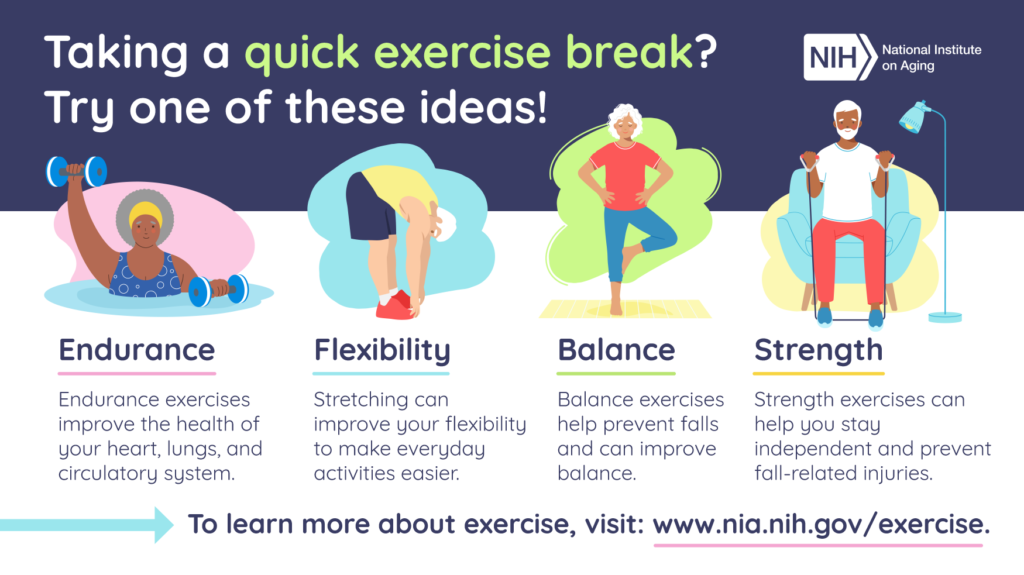
Aerobic Exercises
Aerobic exercises are a fantastic way to improve cardiovascular health, increase stamina, and burn calories. These exercises get your heart rate up and make you breathe harder, which helps deliver oxygen to your muscles and improves their ability to use that oxygen efficiently.
Running
Running is a popular aerobic exercise that requires no equipment and can be done almost anywhere. Whether you prefer jogging in the park or hitting the pavement in your neighborhood, running is a great way to get your heart pumping and burn those extra calories. Plus, it helps strengthen your leg muscles and improves bone density.
Cycling
Cycling is another fantastic aerobic exercise that is low impact and easy on the joints. You can hop on a stationary bike at the gym or enjoy a scenic bike ride outdoors. Cycling not only improves cardiovascular health but also strengthens your lower body muscles, including the thighs, calves, and glutes.
Swimming
Swimming is a full-body aerobic exercise that is gentle on the joints, making it suitable for people of all ages and fitness levels. Whether you prefer freestyle, breaststroke, or backstroke, swimming provides an excellent cardiovascular workout while simultaneously working all major muscle groups. It also helps improve flexibility and coordination.
Jumping Rope
Jumping rope isn’t just for kids; it’s a fantastic aerobic exercise that can be done almost anywhere. It’s affordable, portable, and incredibly effective at increasing your heart rate while improving coordination and agility. Jumping rope also engages multiple muscle groups, including your legs, arms, and core, making it a great total-body workout.
Strength Training Exercises
Strength training exercises are crucial for building and maintaining muscle mass, increasing bone density, and improving overall strength and power. Incorporating strength training into your fitness routine can help with weight management and enhance physical performance.
Weightlifting
Weightlifting involves using free weights or resistance machines to target specific muscles or muscle groups. It helps in building lean muscle mass, improving bone density, and increasing overall strength. Weightlifting can be done with dumbbells, barbells, kettlebells, or resistance bands, providing a versatile and effective way to challenge your muscles.
Push-ups
Push-ups are a classic bodyweight exercise that targets the muscles in your chest, shoulders, triceps, and core. They can be modified to suit different fitness levels, making them accessible for everyone. Push-ups not only build upper body strength but also improve stability and posture.
Squats
Squats are a compound exercise that primarily targets the muscles in your legs, including the quadriceps, hamstrings, and glutes. They can be done with bodyweight or added resistance such as dumbbells or barbells. Squats not only help build lower body strength but also engage your core and improve balance.
Planks
Planks are an excellent exercise for strengthening your core, which includes your abdominal muscles, lower back, and hips. They can be done in various variations, such as forearm planks, side planks, or plank jacks. Planks not only improve core stability but also help in developing strength in your shoulders, arms, and glutes.
Flexibility Exercises
Flexibility exercises are often overlooked but are essential for maintaining joint mobility, preventing injuries, and improving posture. Incorporating stretching and other flexibility exercises into your fitness routine can help enhance muscle flexibility and reduce muscle soreness.
Stretching
Stretching is a fundamental exercise for improving flexibility and range of motion in your joints. It can be done as a standalone activity or incorporated into your warm-up and cool-down routines. Stretching targets specific muscles or muscle groups and helps relax tight muscles, increase blood flow, and enhance overall flexibility.
Yoga
Yoga combines physical postures, breathing exercises, and meditation to promote physical and mental well-being. It improves flexibility, strength, balance, and promotes relaxation. Various yoga styles, such as Hatha, Vinyasa, or Ashtanga, cater to different fitness levels and goals, making it suitable for beginners and experienced practitioners alike.
Pilates
Pilates is a low-impact exercise method that focuses on developing core strength, flexibility, and overall body awareness. It involves precise movements and controlled breathing techniques to engage and strengthen the deep muscles of the abdomen, back, and pelvic floor. Pilates can be done using specialized equipment or through mat-based exercises.
Tai Chi
Tai Chi is an ancient Chinese martial art that combines slow, flowing movements with deep breathing and relaxation techniques. It promotes balance, flexibility, and mind-body connection. Tai Chi is often practiced as a gentle exercise suitable for all ages and fitness levels, providing a calming and meditative approach to improving flexibility.
Balance Exercises
Balance exercises are vital for improving stability, preventing falls, and enhancing coordination. They help strengthen the muscles responsible for maintaining balance and stability, allowing you to move with confidence and reduce the risk of injuries.
Single-leg stance
The single-leg stance is a simple but effective balance exercise that can be done anywhere. Stand on one leg and try to maintain your balance for 30 seconds or longer. This exercise strengthens the muscles in your ankles, calves, and hips, improving overall stability and coordination.
Heel-to-toe walk
The heel-to-toe walk, also known as the tandem walk, challenges your balance and coordination. Walk in a straight line, placing the heel of one foot directly in front of the toes of the other foot with each step. This exercise engages the muscles in your legs, core, and improves proprioception.
Yoga tree pose
The tree pose is a yoga posture that improves balance, stability, and concentration. Stand with your weight on one leg, bend the opposite knee, and place the foot on the inner thigh of the standing leg. Find your balance and extend your arms overhead or in prayer position. The tree pose strengthens the muscles in your legs and core while improving focus and stability.
Standing knee raises
Standing knee raises target the muscles in your legs, particularly the quadriceps and hip flexors, while also improving balance. Stand tall with your feet hip-width apart and raise one knee towards your chest, maintaining your balance. Alternate legs and gradually increase the height of your knee raises as your balance improves.
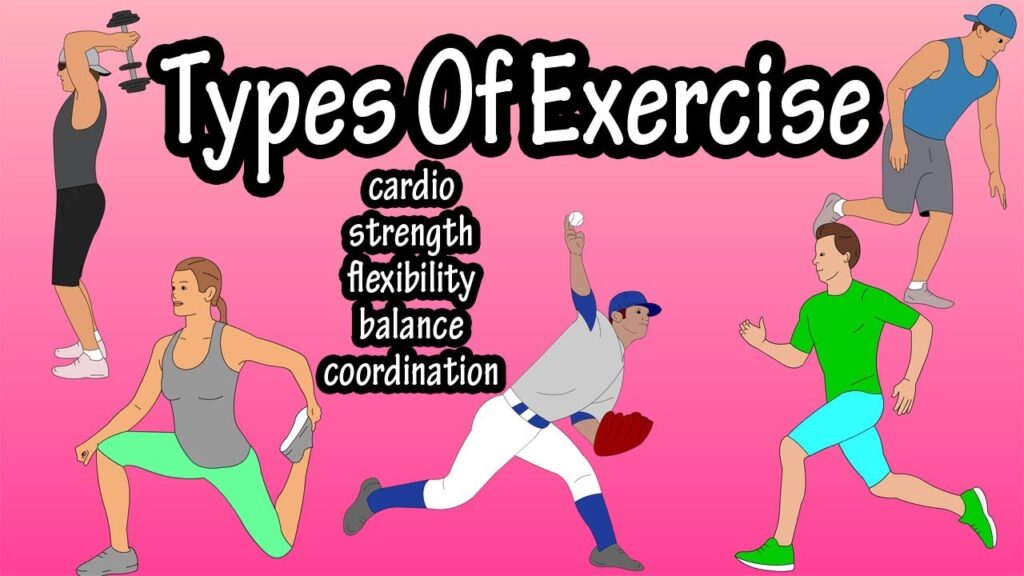
High-Intensity Interval Training (HIIT)
High-Intensity Interval Training (HIIT) involves short bursts of intense exercise followed by brief recovery periods. It is a time-efficient and effective way to burn calories, boost metabolism, and improve cardiovascular fitness.
Tabata
Tabata training is a specific form of HIIT that consists of 20 seconds of intense exercise followed by 10 seconds of rest, repeated for a total of 8 rounds (4 minutes). This type of training can be done with various exercises, such as sprints, burpees, or kettlebell swings. Tabata is a high-energy workout that pushes your limits and maximizes calorie burn.
Circuit Training
Circuit training involves performing a series of exercises targeting different muscle groups with minimal rest in between. It combines strength training and aerobic exercises, providing a well-rounded workout that improves strength, endurance, and cardiovascular fitness. Circuit training can be customized to suit your fitness level and preferences, making it a versatile option for all.
Sprint Intervals
Sprint intervals involve alternating short bursts of all-out sprinting with active recovery periods. This type of HIIT can be done on a track, treadmill, or outdoor space. Sprinting engages and strengthens the lower body muscles, improves cardiovascular fitness, and increases calorie burn. It’s a challenging yet rewarding form of exercise.
Endurance Exercises
Endurance exercises focus on improving your stamina and ability to sustain physical activity over an extended period. These exercises primarily target your cardiovascular system, helping your body efficiently use oxygen and maintain energy levels.
Long-distance running
Long-distance running is a classic endurance exercise that challenges your cardiovascular system and builds stamina. Whether you’re training for a marathon or simply enjoy going for long runs, distance running helps improve cardiovascular fitness, burn calories, and boost mental endurance.
Cycling
Cycling, especially long rides, is an excellent endurance exercise that targets the muscles in your legs, as well as providing a cardiovascular workout. Whether you prefer stationary cycling or exploring scenic routes outdoors, cycling helps improve mental focus, builds leg strength, and enhances cardiovascular health.
Swimming
Swimming is not only a fantastic aerobic exercise but also an excellent endurance activity. Whether you’re swimming laps in a pool or enjoying open water swimming, this low-impact exercise engages all major muscle groups while providing a refreshing and challenging workout that improves lung capacity and overall endurance.
Rowing
Rowing is a total-body workout that builds endurance and strength. Whether you’re rowing on a machine at the gym or enjoying the outdoor experience on a rowing boat, this exercise engages your upper body, core, and legs while providing a low-impact cardio workout. Rowing helps improve cardiovascular fitness, coordination, and muscular endurance.

Plyometric Exercises
Plyometric exercises, also known as jump training, involve explosive movements that engage your muscles and boost power. These exercises enhance muscular strength, speed, and agility, making them beneficial for athletes and individuals looking to improve their athletic performance.
Box jumps
Box jumps involve jumping onto a sturdy box or platform and then stepping or jumping down. This exercise targets your leg muscles, including the quadriceps, hamstrings, and glutes, as well as improving explosive power and stability. Start with a lower box height and gradually increase as you build strength and confidence.
Burpees
Burpees are a full-body plyometric exercise that combines a squat, plank, push-up, and jump. This high-intensity exercise engages multiple muscle groups, including your legs, core, chest, shoulders, and arms. Burpees help improve cardiovascular endurance, build strength, and burn calories in a short amount of time.
Medicine ball slams
Medicine ball slams require throwing a weighted ball down to the ground with force and catching it on the rebound. This exercise targets your core, shoulders, and upper body muscles while developing power and explosiveness. Medicine ball slams can be performed with various ball weights, allowing you to progress gradually.
Jump lunges
Jump lunges are a dynamic plyometric exercise that combines lunges with explosive jumps. Start in a lunge position, then jump up and switch legs mid-air, landing in a lunge with the opposite leg forward. This exercise targets your quadriceps, hamstrings, glutes, and improves lower body strength, power, and stability.
Low-Impact Exercises
Low-impact exercises are gentle on the joints, making them suitable for individuals with joint pain or those looking for a less intense workout. These exercises help improve cardiovascular health, muscular strength, and flexibility while minimizing stress on the joints.
Elliptical trainer
Using an elliptical trainer provides a low-impact cardiovascular workout that engages both the upper and lower body. It mimics the motion of walking or running without putting excessive stress on the joints. The elliptical trainer helps improve cardiovascular fitness, leg strength, and overall endurance.
Swimming
Swimming, mentioned earlier as an aerobic and endurance exercise, is also an excellent low-impact option. The buoyancy of water reduces the impact on your joints while providing resistance for muscular strength and cardio training. Swimming is particularly beneficial for individuals with joint issues or those recovering from injuries.
Yoga
Yoga, mentioned earlier as a flexibility exercise, also provides a low-impact workout that combines stretching, strengthening, and mindfulness. Practicing yoga can improve flexibility, balance, and overall body strength while enhancing mental well-being. Various yoga styles and levels make it accessible to individuals of all fitness levels.
Cycling
Cycling, mentioned earlier as an aerobic and endurance exercise, is also a low-impact activity. Whether indoors or outdoors, cycling reduces impact on the joints while targeting the muscles in your legs, glutes, and lower back. It provides a cardiovascular workout without the stress often associated with higher-impact exercises.
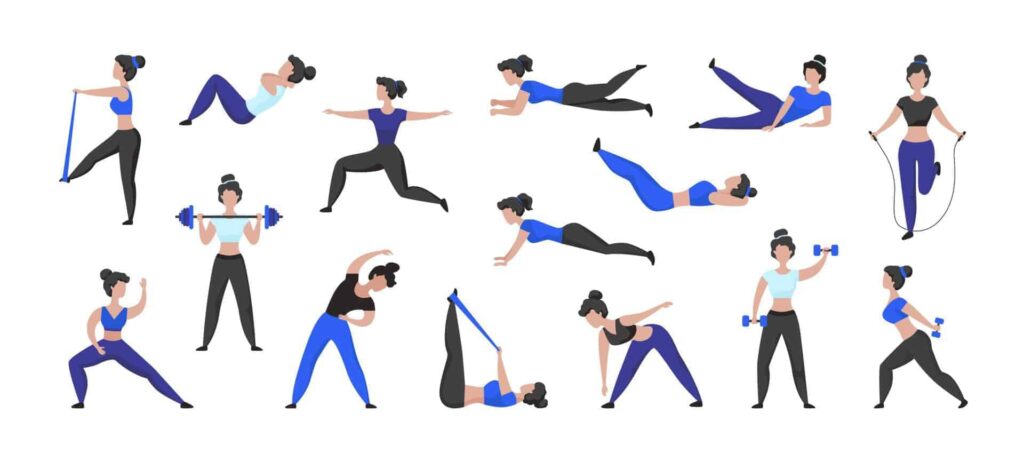
Isometric Exercises
Isometric exercises involve contracting specific muscles without joint movement, thereby increasing muscle strength and endurance. These exercises are beneficial for improving stability, core strength, and overall muscular control.
Planks
Planks, mentioned earlier as a core-strengthening exercise, are also considered an isometric exercise. By holding a static position, such as a forearm or high plank, you engage your core muscles, shoulders, arms, and glutes. Planks build strength, stability, and endurance, making them a highly effective exercise for overall body control.
Wall sits
Wall sits involve maintaining a sitting position against a wall, with your knees at a 90-degree angle and your back pressed against the wall. This isometric exercise targets the muscles in your thighs, particularly the quadriceps, while also engaging your core. Wall sits improve lower body strength, endurance, and stability.
Static lunges
Static lunges involve holding a lunge position with your front knee bent at a 90-degree angle and your back knee almost touching the ground. This isometric exercise targets the muscles in your legs, primarily the quadriceps and glutes, while also engaging your core. Static lunges help build lower body strength, stability, and balance.
Leg extensions
Leg extensions involve sitting on a machine with your knees bent and lifting the weighted pad in front of you using your quads. This isometric exercise is particularly effective in targeting and strengthening the muscles in your thighs. Leg extensions improve quadriceps strength and stability, making them a valuable exercise for knee health and overall lower body strength.
Core-Strengthening Exercises
Core-strengthening exercises focus on strengthening the muscles in your abdomen, lower back, and pelvis. A strong core improves stability, posture, and overall functional movement, making it essential for everyday activities and fitness performance.
Crunches
Crunches are a classic core exercise that targets the muscles in your upper and lower abdomen. Lie on your back, bend your knees, and lift your torso towards your thighs. Crunches strengthen the rectus abdominis and obliques, improving core stability and helping to develop defined abdominal muscles.
Russian twists
Russian twists primarily target the muscles in your obliques, which are the side muscles of your abdomen. Sit on the floor, lean back slightly, and twist your torso from side to side while keeping your feet raised slightly off the ground. Russian twists strengthen the core and improve rotational stability and strength.
Bicycle crunches
Bicycle crunches engage multiple muscle groups, including the upper and lower abs, obliques, and hip flexors. Lie on your back, bring your knees toward your chest, and alternately twist your torso, bringing your elbow to meet the opposite knee. Bicycle crunches improve core strength, stability, and coordination.
Planks
Planks, mentioned earlier as an isometric and core-strengthening exercise, are highly effective for developing overall core strength. By holding a plank position, you engage your abdominal muscles, lower back, and glutes. Planks help improve core stability, posture, and overall strength for various movements and activities.
Incorporating a variety of different types of exercises into your fitness routine provides a well-rounded approach to physical fitness. Whether you’re looking to improve cardiovascular health, increase strength, boost flexibility, or enhance balance, there is a wide range of exercises to choose from. Remember to listen to your body, start at your own pace, and gradually increase intensity as your fitness level improves. Stay consistent, have fun, and enjoy the journey towards a healthier and fitter you!
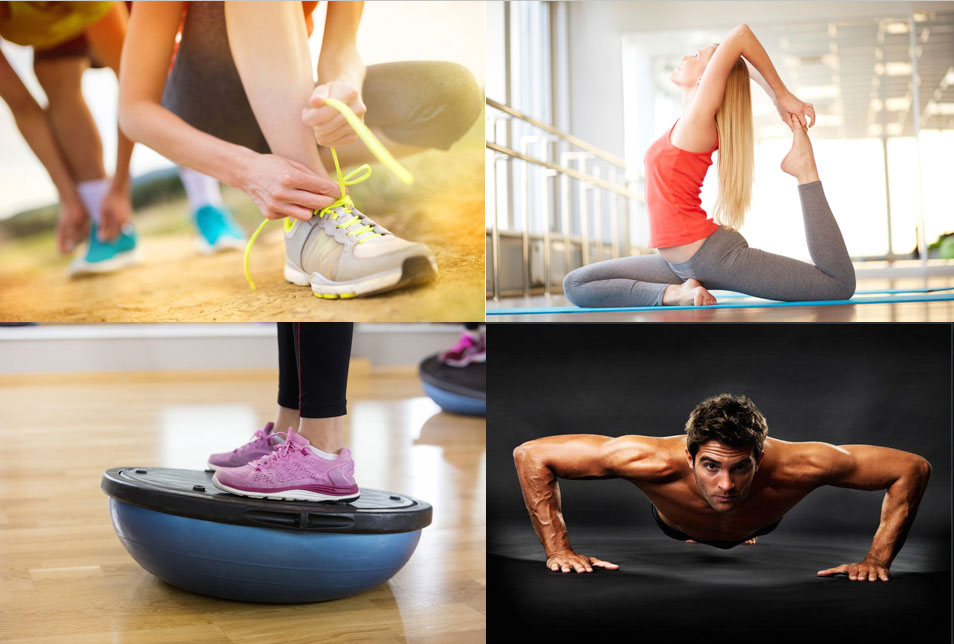

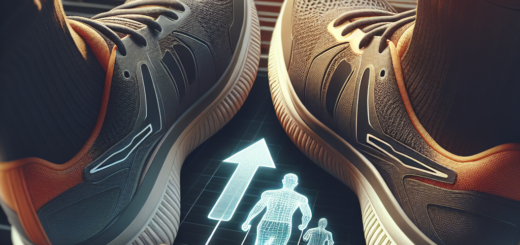
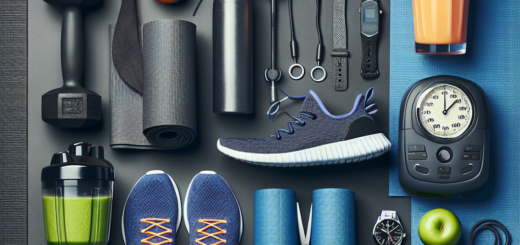














It's great that you talked about how business insurance can provide financial protection against unexpected events and help ensure the…
I like that you mentioned how business insurance is essential for protecting your bottom line and the long-term viability of…